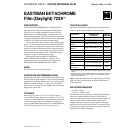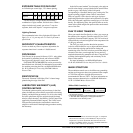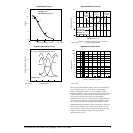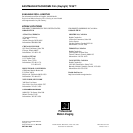
©Eastman Kodak Company, 1998
TECHNICAL DATA / COLOR REVERSAL FILM
February 1999 • H-1-5239
H-1-5247
August 1996
EASTMAN EKTACHROME
Film (Daylight) 7239
™
DESCRIPTION
EASTMAN EKTACHROME Film 7239 (Daylight) is a
high-speed color reversal film intended for photography
under low-level daylight illumination. Among its many
applications are news photography, sporting events, and
high-speed photography. The processed original camera film
is ready for projection; because it is balanced for projection
at 5400 K, it is suitable for television broadcasting.
You can expose this film at effective film speeds ranging
from
1
⁄
2
to 2 times the normal exposure indexes with little
loss in quality. For emergency situations when some loss in
quality is acceptable, increase the normal exposure index by
the equivalent of 2 to 3 stops. When you expose the film at
other than the normal exposure index, tell the processing
laboratory so they can adjust the processing.
The processed camera original on EASTMAN
EKTACHROME Film (Daylight) is meant for direct
projection; however, you can make color duplicates on
EASTMAN EKTACHROME Print Film 7399.
BASE
This film has a clear acetate safety base.
DARKROOM RECOMMENDATIONS
Handle unprocessed film in total darkness until after the stop
bath following first development. You can do the remaining
operations in a normally lighted room. Use a safelight with a
KODAK Safelight Filter No. 3 / dark green to illuminate
dials, meters, etc, during first development; do not shine the
light directly on the film.
STORAGE
Store unexposed film at 13˚C (55˚F) or lower. Process
exposed film promptly. Store processed film at 21˚C (70˚F)
or lower at a relative humidity of 40 to 50 percent for normal
commercial storage. For more information on long-term
storage, see KODAK Publications No. H-1, KODAK Motion
Picture Film, and No. H-23, The Book of Film Care.
COLOR BALANCE
This film is balanced for daylight exposure. For other light
sources, use the correction filters in the table below.
Note: Consult the manufacturer of high-intensity ultraviolet
lamps for safety information on ultraviolet radiation and
ozone generation.
EXPOSURE INDEX/DIN
Daylight—160/23
Tungsten
*
(3200 K)—40/17
Use these indexes with incident- or reflected-light exposure
meters and cameras marked for ISO or ASA speeds or
exposure indexes. These indexes apply for meter readings of
average subjects made from the camera position or for
readings made from a gray card of 18-percent reflectance
held close to and in front of the subject. For unusually light-
or dark-colored subjects, decrease or increase the exposure
indicated by the meter accordingly.
Light Source
KODAK Filters
on Camera*
* These are approximate corrections only. Make final corrections during
printing.
Exposure
Index/DIN
Daylight (5500 K) None 160/23
Tungsten (3000 K) WRATTEN Gelatin No. 80A 40/17
Tungsten lamps
(3200 K)
WRATTEN Gelatin No. 80A 40/17
Tungsten photoflood
(3400 K)
WRATTEN Gelatin No. 80B 50/18
Metal halide H.M.I. None 160/23
White-flame arcs None 160/23
Yellow-flame arcs WRATTEN Gelatin No. 80A 40/17
Optima 32 WRATTEN Gelatin No. 80A 40/17
Vitalite None 160/23
Fluorescent Cool
White†
† These are starting-pointrecommendations fortrial exposures. Whenyou
don’t know the type of fluorescent lamps, use a CC20M filter with an
exposure index of 100/21.
Color Compensating 30M 100/21
Fluorescent Deluxe
Cool White†
Color Compensating 20B 100/21
*With a KODAK WRATTEN Gelatin Filter No. 85B.






